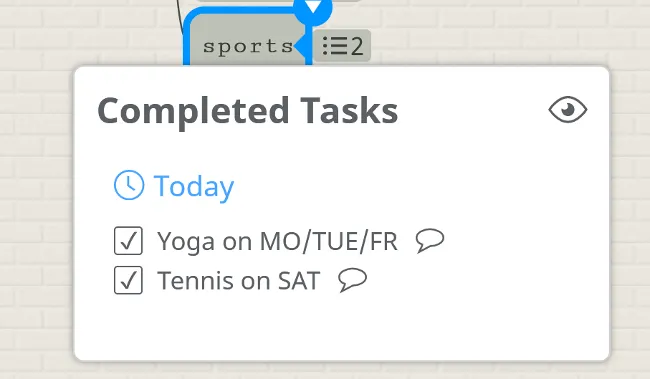How to make the most of your Premium membership
Mindomo Premium is tailored for professionals who want to enhance their personal and organizational skills in areas like critical thinking, problem-solving, and project management. Whether you’re a business manager, entrepreneur, or young professional, Mindomo helps you streamline workflows, organize ideas, and improve decision-making in both business and personal contexts.
For Who and Why?
Section titled “For Who and Why?”Information gathering and organizing, problem analysis, and decision-making are part of any project. And it could easily get overwhelming. Mindomo Premium is designed for professionals looking to advance their personal, organizational, and task management skills:
- employees in a business environment
- executive directors
- business managers
- entrepreneurs
- marketers
- sales team representatives
- training and development specialists
- human resources officers
- nonprofit founders
- young professionals entering the job market, etc.
In 2016’s “Future of Jobs” report from the World Economic Forum, leading global employers predicted that Critical Thinking will become the 2nd most important skill for employees by 2020. This prediction is achieved, and the top skills that employers see as rising in prominence in the lead-up to 2025 include critical thinking, analysis, and problem-solving.
In a business or private scenario, using the Mindomo Premium suits you if you plan to:
-
structure your business strategies, risk analysis, brainstorming, and problem-solving processes
-
evaluate the progress of your business initiatives
-
streamline product development
-
prioritize your work, manage deadlines, and delegate tasks
-
improve communication strategies
-
take notes during reunions and highlight the key points discussed
-
make visual representations of your professional or personal goals
-
facilitate smooth operations, etc.
Improving your work and personal life
Section titled “Improving your work and personal life”Effective lifelong learning
Section titled “Effective lifelong learning”
Why? To keep up the pace in today’s dynamic environment, yet feel truly self-actualized. How? Put your mind in motion and question things to always understand things better.
As an adult, you choose to learn something because you see its value. You look for relevant material that you can connect to your experience. It’s your interests and ambitions that drive learning.
By creating diagrams in Mindomo, you’ll be the one asking the questions and finding the answers. This will walk you through all of the phases of inquiry-based learning:
-
Interaction - research different media sources to identify the central topic of the inquiry
-
Clarification - summarizing and categorizing information in a diagram of your choice
-
Questioning - asking relevant questions to drive self-directed inquiry
-
Design - designing an accessible, relevant, and engaging diagram to justify inquiry
Once you lit your curiosity of always wanting to understand things, you will forever seek knowledge instead of data and information.
The gift of autonomy
Section titled “The gift of autonomy”
Get used to thinking for yourself in uncertain and complex situations in which judgment is more important than routine. Being autonomous means you’ll have the intellectual ability to be confident and bold with your ideas rather than to be well organized. As long as you have logical arguments, you shouldn’t be afraid of crossing the conventional line.
Relaxed collaboration
Section titled “Relaxed collaboration”
Collaborating within a team requires soft skills like flexibility, problem-solving, and decision-making. Mindomo is a highly visual and spatial platform accessible on a desktop, laptop, or mobile device, allowing you to collaborate inside and outside the office and beyond your work day. While you work together with collaborators on the same diagram, some will identify key points, and others will see the connections and generate new ideas. Having everything organized will make the entire team better prepared and eager to deliver.
Objectivity in a post-truth world
Section titled “Objectivity in a post-truth world”
From the endless stream of political misinformation to inescapable distortion on social media, truth and essence are at risk - we’re in danger of losing sight of what truth means and what truly matters. Diagramming in Mindomo will help you to keep your thinking simple and stick to the essentials:
- make information straightforward
- be selective and prioritize key aspects
- put your clear thoughts down on an infinite canvas where erasing, editing, and reorganizing the content are one click away
Independent thought process
Section titled “Independent thought process”
An independent, reasoning thought process is vital for solving problems. It walks you through formulating arguments from evidence while identifying opportunities and threats. Creating diagrams in Mindomo requires a process-centered focus on knowledge and objective evidence – and in the business world, this is a time and money-saving skill from top to bottom.
Why Mind Maps?
Section titled “Why Mind Maps?”Mirror the way our brains think
Section titled “Mirror the way our brains think”
Using mind maps for work and personal development fits the way our brain works. That sage saying “a picture is worth a thousand words” is backed up by science. Our brains process visuals 60,000 times faster than words. Studies also show our brains not only process visuals faster than words but we retain and transmit much more information when it’s delivered visually.
Combine right and left hemispheres
Section titled “Combine right and left hemispheres”
Our brains have two major hemispheres, each with its ways of thinking and processing. The left side is logical, linear, and analytical. The right side is intuitive, creative, and visual. Only by using both sides consistently can students grow personally and professionally.
Mind mapping brings right and left brain hemispheres together. Breaking information into concepts and organizing them hierarchically - left hemisphere. Using shapes, pictures, and colors - right hemisphere. The left brain visualizes the overall image, while the right brain identifies all of the steps necessary to complete the map.
Prompt critical thinking
Section titled “Prompt critical thinking”
Apart from the visual aspects, the mind map creation process encourages you to develop a healthy questioning and rationalizing attitude.
First, you take the information you know and identify the core. Then, you break everything into smaller pieces, based on importance and hierarchy. Third, you put your mind to work and look for connections between new information and what you already know.
During the entire time, you’ll be processing information through synthesis, analysis, interpretation, explanation, evaluation, generalization, comparison, and contrast.
Plan and Organize Your Work
Section titled “Plan and Organize Your Work”Simplified brainstorming
Section titled “Simplified brainstorming”
Either as a solo entrepreneur or within a group of professionals, you can use brainstorming as a key component of successful idea generation. From coming with a new product idea to boosting income in your existing business, from debriefing internal procedures to collecting viewpoints, from building teams to encouraging stakeholders’ future endeavors, brainstorming is vital to the success of any project.
💡 Tips and Tricks
Brainstorming sessions are great icebreakers that you can modify in many ways to make them more relaxed or more focused, depending on the context:
Blank cluster diagram - ready for use on any topic. One can freely associate ideas with the main topic.
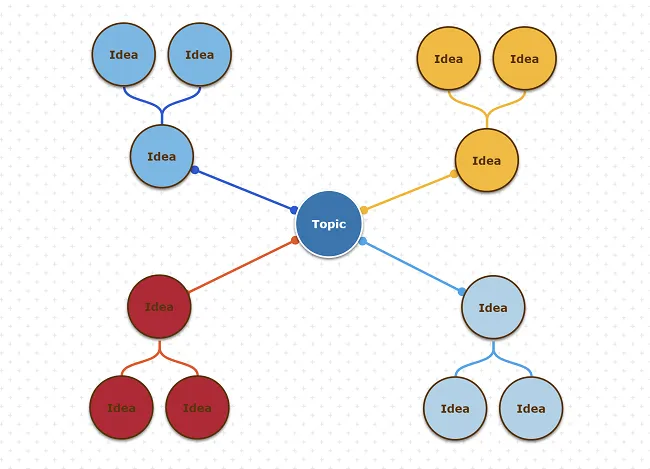
Brainstorming with cues - guide the brainstorming session by using verbal or visual cues or a combination of both. Share prefilled mind maps and concept maps that need further editing.
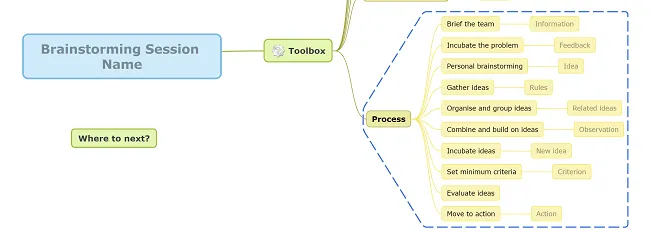
You can browse Mindomo’s gallery for other inspiration map templates:

Make sure you ask the right questions before and during the brainstorming session:
- how should I/we act during brainstorming?
- how long will I/we spend on each section of the mind map?
- what should be discussed/ignored?
- who gets the final say on the next steps?
Consider these open-ended observational questions to kick-start your brainstorming:
-
what’s to notice about the product?
-
what are we trying to achieve in this session?
-
what concrete steps should we take to move forward?

Either alone or in small groups, feel free to use this brainstorming questions diagram and create your own maps with the highlights.
These maps can make room for more discussions as they are presented at meetings. Returning to the same questions months later might allow you and/or your teammates to show that your independent thinking skills have improved and that you are ready to turn ideas into projects.
Business project management
Section titled “Business project management”
Project management’s definition as per Wikipedia - “the process of leading the work of a team to achieve all project goals within the given constraints”. So, how do you effectively process all of the data without losing track of the big picture? Mind mapping can keep you efficiently moving forward through the 4P’s of Project Management:
-
People: the primary resource in every project. Identifying the roles people play can greatly increase the project’s chances for success.
-
Product: the deliverable of the project, must address the right problem.
-
Process: using the right process will ensure team members know what to do and when to do it, therefore meeting the project’s original goals and objectives.
-
Project: where the project manager comes into play. Planning, delegating tasks, helping the team to communicate, and closely supervising to accomplish all requirements.
💡 Tips and Tricks
Search Mindomo’s templates gallery for prefilled mind maps and templates like the business project mind map below to help you set the stage for project success.
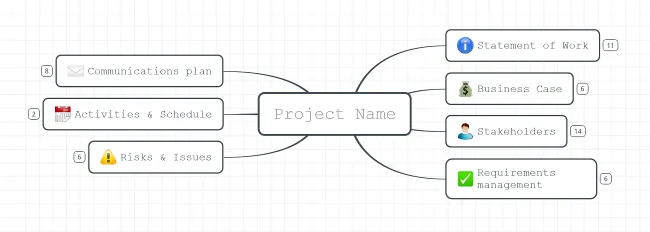
For small, well-defined projects, you can opt for the traditional phased approach and create a project management mind map with all the five process areas: Initiation, Planning, Production or Execution, Monitoring and Controlling, and Closing.
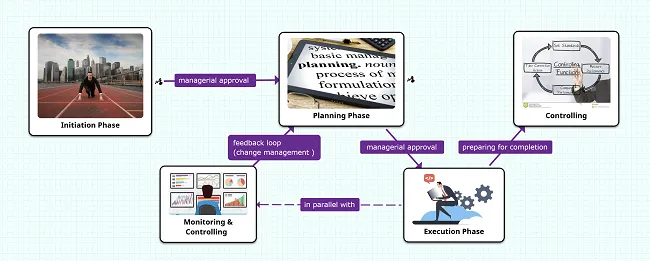
Each main branch of the mother map can link to a different diagram covering a specific process area. Feel free to copy and edit the diagrams below.
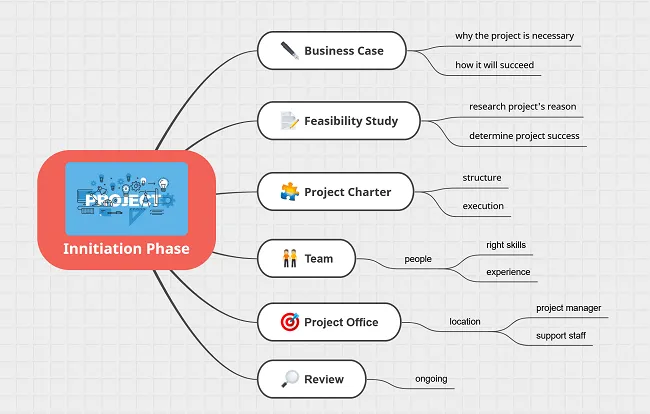
You can create mind maps to draft all the project initiation documents meant to establish the order for the entire duration of the project:
- project proposal (idea, goal, duration)
- project scope (project direction and track)
- product breakdown structure (PBS) (a hierarchy of deliverables)
- work breakdown structure (WBS) (a hierarchy of to dos down to daily tasks)
- responsibility assignment matrix (RACI) (roles and responsibilities aligned to deliverables/outcomes)
- tentative project schedule (milestones, important dates, deadlines)
- analysis of business needs and requirements against measurable goals
- review of the current operations
- financial analysis of the costs and benefits
- stakeholder analysis
- project charter
- SWOT analysis

You can create mind maps to draft all the project planning documents required for planning and estimating time, costs, resources, the work needed, risk management, etc. These documents often consist of:
- project management methodology
- scope statement
- team selection
- network of deliverables and related activities
- resources requirements estimation
- time and cost estimation
- project schedule
- risk planning
- quality assurance measures
- formal approval for execution

Create tasks, assign them, and closely follow up on their progress to ensure that the project management plan’s deliverables are executed accordingly.
Documenting each specific task (add the assignee(s), notes, comments) in the project is key to being successful. By adding deadlines and marking completed tasks as done, everyone will be able to track the progress as the project moves forward.
Monitoring & Controlling Phase mind map:
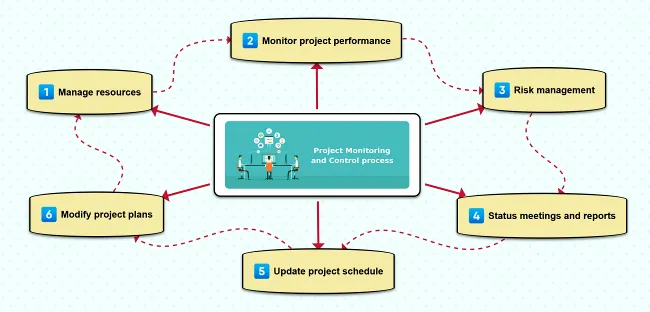
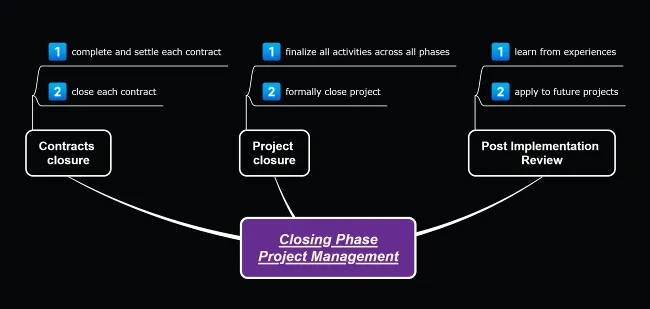
Other ways to leverage the benefits of mind maps for project management:
-
highlight the minutes of your business meetings in less time and a more communication-efficient manner
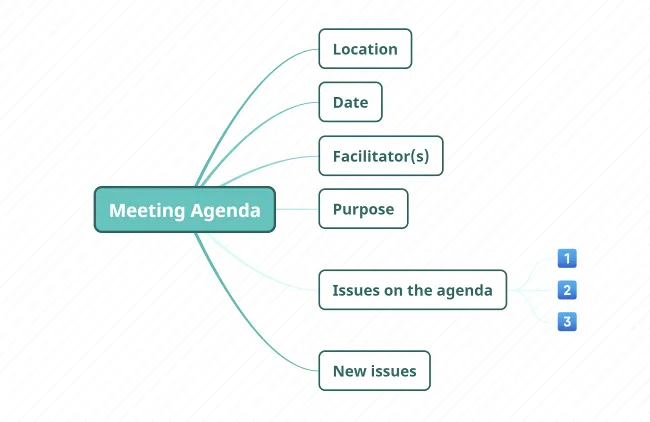
-
solving specific problems

-
create an organizational structure to have a clear overview of who is reporting to who inside your team
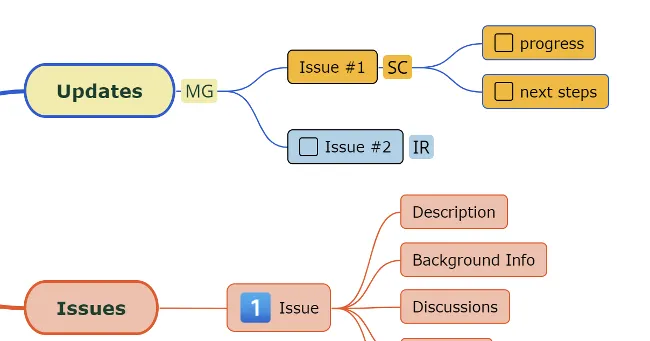
-
organize unstructured ideas on how to make the final product better, etc.
Project reviews
Section titled “Project reviews”
Project reviews serve a wide range of stakeholders and fulfill a variety of roles, therefore the different types of review, each with its focus and outcomes:
-
Project Health Check/ Project Evaluation
-
Gate Review
-
Project Audit
-
Benefits Realization Review
-
Post-Implementation Review
💡 Tips and Tricks
The Project Health Check mind map can assit you with the review at any point throughout the project. It typically assesses the likelihood of project success, and identifies risks and corrective actions. Choose an organized diagram layout to highlight all the areas that need to be checked.

Turn the topics with the areas of interest into tasks so you can mark them as completed once you manage to evaluate them.
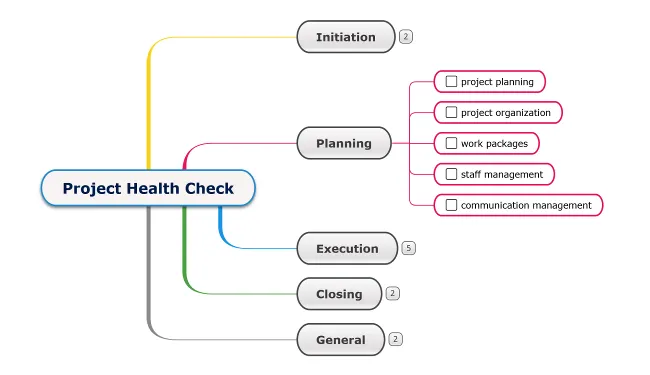
The Post-Implementation mind map will help you answer the following key questions:
-
Did the project fully solve the problem it was meant to address?
-
What would be the next steps for delivering even bigger benefits?
-
Lessons learned that we can apply to future projects?

Consider using this project review template as a starting point for your own project review mind map.
Custom SWOT analysis
Section titled “Custom SWOT analysis”
By conducting a SWOT analysis, you zoom in on the factors that might help or hinder your project’s success. If you fully understand its strengths, weaknesses, opportunities, and threats, you’re better prepared to plan for success. You can take advantage of what your team does best while defending against the weaknesses and threats to your project.
💡 Tips and Tricks
To create an engaging, easy-to-follow SWOT analysis for you and your team members, without investing too much time, use our customizable SWOT analysis mind maps. Maybe you’ll want to keep the look and feel, but edit their content, or vice versa. In the end, the SWOT analysis should fit your/your company’s specific strengths and weaknesses.
Create strategy from SWOT mind map:
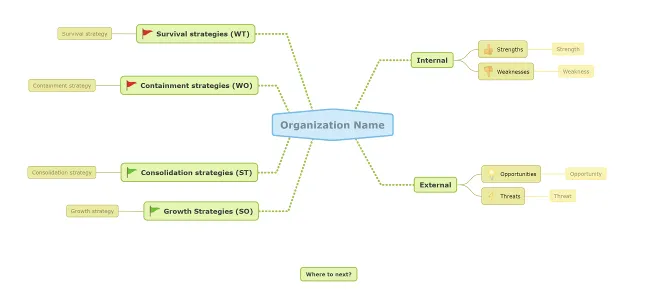
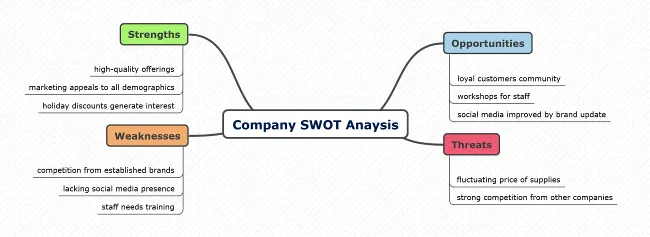


Non-governmental organization SWOT mind map:

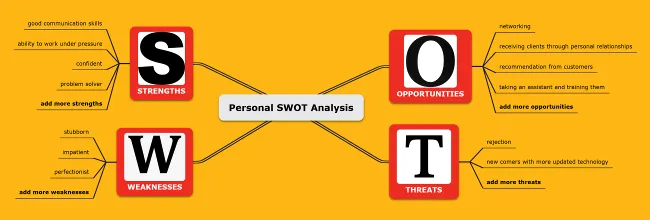
Feel free to update the fonts, colors, shapes, and icons to perfectly match your brand identity. Read more about Mindomo’s topic and map theme customization features.
Share the SWOT mind map with all key stakeholders (team members, clients, sponsors, etc.) to help you identify and analyze critical factors so that nothing gets overlooked. If some of your key stakeholders don’t have Mindomo accounts, they can work as guests on diagrams using fully premium features.
Consider using this stakeholder wheel mind map to identify your stakeholders and classify them based on their importance.
Market research
Section titled “Market research”
Is the market ready for your new service or product? Finding the product-market fit requires market research so you can get honest opinions and consumer feedback. Either it’s conducted in-house, by the company itself, or by a specialized third-party company, market research implies gathering lots of information that needs to be analyzed and interpreted. Diagramming in Mindomo will clarify your thinking and simplify everything from structuring information to analyzing, synthesizing, and generating new ideas.
💡 Tips and Tricks
Opt for well-organized, easily accessible, and illustratable information. Choose the diagram theme that appeals most to you in terms of layout and color scheme.
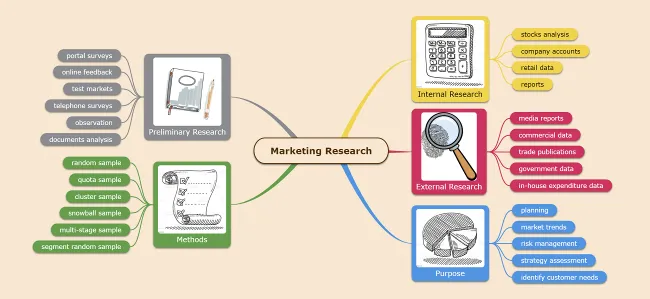
Turn all areas in your research into expandable branches that contain all the details you need to focus on. For a bird’s eye view on complex diagrams, collapse them with CTRL+ 0. Delve into the content by expanding the diagram level by level with CTRL + 1/2/3/4. See all Mindomo shortcuts.

Consider using our general marketing research mind map template and adapting it to your specific needs.
Visualize your research methods to find the right mix for your particular goals and what you need to know about your targeted consumers:
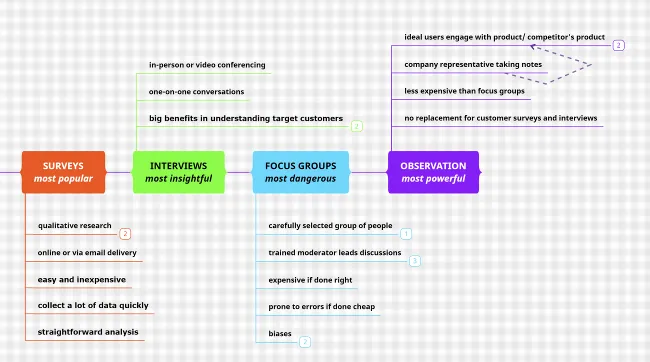
Get ready to know your users on a deeper level with our market research interview diagram:

Feel free to edit this concept map in any way you see fit to draft your interview questions. As soon as you finish your diagram, you can turn it into an outline for further editing and printing.

If you want to get quick, actionable insights, build your own solid framework for market research, covering the following aspects:
-
simple user personas
-
observational research
-
individual interviews
-
data analysis that is not overwhelming (custom diagrams)

Each main topic from the mother diagram should link to a different diagram (read more on adding hyperlinks in a map here):

Observational Research diagram

Market research interviews diagram
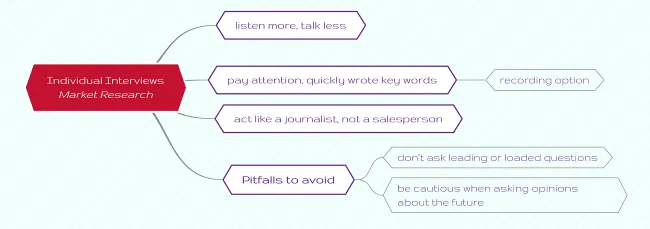
Market research data analysis diagram

Consider using Porter’s Five Forces analysis template to analyze in detail your company’s competitive environment.
To document your research with resources such as book excerpts, brochures, journals, magazines, newspapers case studies, etc., you can browse and attach web photos, or create hyperlinks to their location on the web.

If you collect research data through observation, you should consider adding personal audio files and even record your speech directly in Mindomo.
You can add a resource as hyperlink to a word or phrase or as a topic attachment.
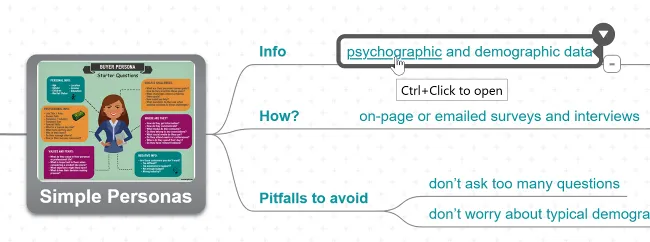
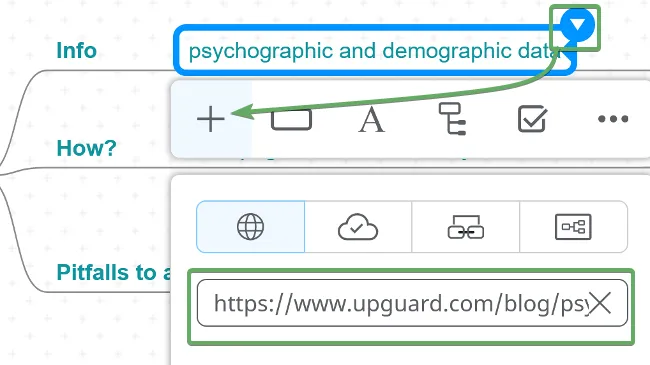

You can also use any of your saved Mindomo Bookmarks (text, links, images) relevant to the research you are conducting:
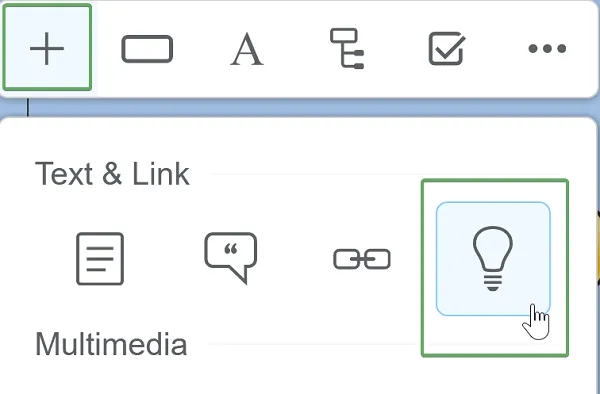
Marketing action plans
Section titled “Marketing action plans”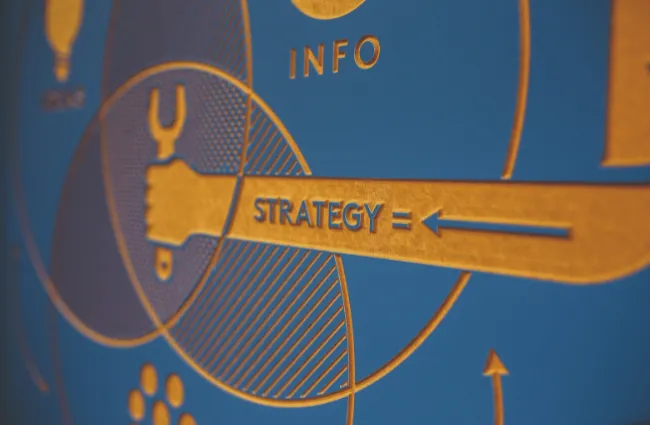
All marketers have strategic roadmaps that help them ideate, organize, execute, and track their marketing strategy. Diagramming in Mindomo will make your action plans both creative and organized, keeping you on track with the progress and success of every step of your campaign.
💡 Tips and Tricks
Start with a generic action plan template to help you meet your online, marketing, content, or promotional goals, or a detailed action plan template that walks you through market research, marketing strategy, setting up your USP, budgeting details, etc.

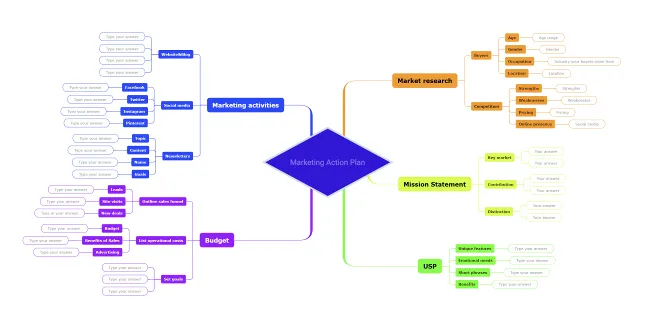
Document your ideas by uploading personal documents and videos from your computer, Google Drive, OneDrive, and Dropbox accounts.
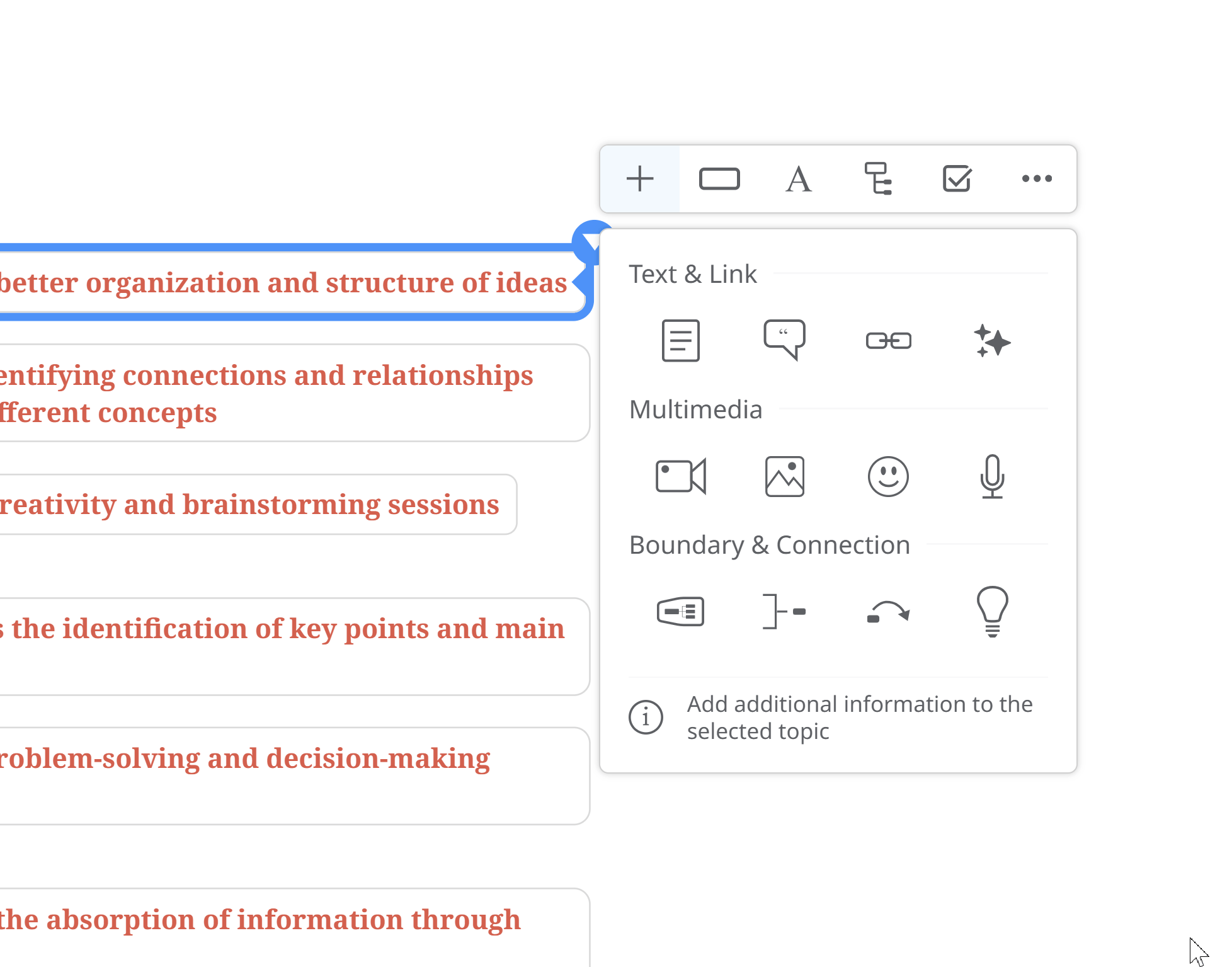
Copying and pasting info from one diagram to another (including links, images, notes, and other resources) is a time-saving feature. Read more about it here.
Note creation to keep larger bodies of text hidden from the big picture. For example, the market plan includes situation analysis, market analysis, objectives, marketing strategy, action plan, each with its own focus points. You can create notes for each key point and go over the details if needed without losing your focus.
At any point, no matter how complex the diagram becomes, they can quickly find specific content using Search and Filter options.
Meeting and event planning
Section titled “Meeting and event planning”
Attending meetings and events can deliver a tremendous return on investment in terms of networking, education, marketing, sales, etc. Conversely, the impact of a poorly executed meeting or event can be substantial.
Map out a sound foundation for successfully planned and executed events, altogether covering everything from:
-
setting goals and objectives for the meeting/event
-
planning program content
-
planning on-site procedures and policies
-
revenue and expense analysis
-
risk management
-
contingency planning
-
handling reservations and housing
-
managing supplier relationships
-
volunteer recruitment, management, and orientation
-
to post-event evaluation
💡 Tips and Tricks
Consider a timeline diagram for a clear overview of the chronological order of events.
Depending on the different event types you’re organizing at the moment, categorize them to make it easier for you to find and update details on the spot. Use hashtags, icons, and color-coding to make information easily accessible. See how filtering by hashtag or icon works.
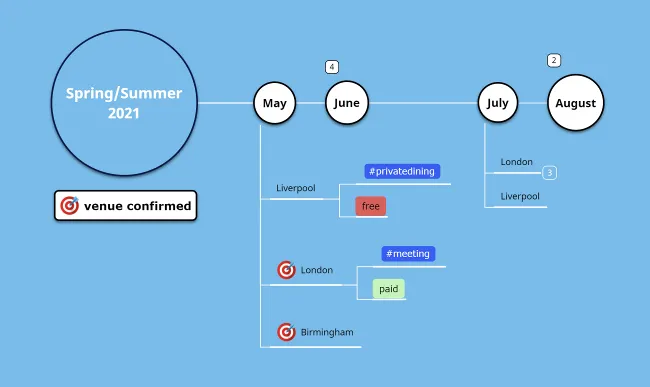
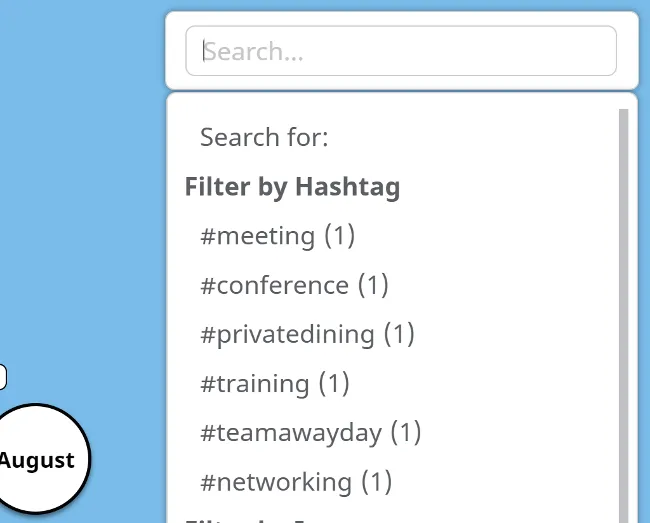
Assign tasks and set deadlines to be on track with the major milestones and progress of your event.
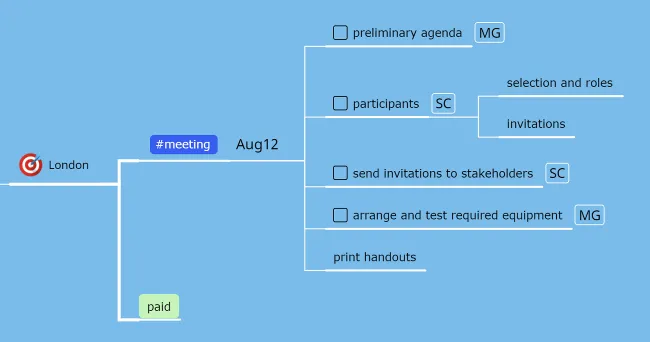
Browse Mindomo’s templates gallery for other planning templates like this business workshop planning diagram.
Website planning
Section titled “Website planning”
Did you know that 88% of online consumers are less likely to return to a website after a bad experience? So careful website planning sounds like a good investment. Mindomo empowers you to visualize the software architecture, website requirements, and a winning website strategy.
💡 Tips and Tricks
Choose an organized layout that lets you nest all crucial steps in building your website, documenting everything with links and attachments, images, videos, audios and recordings, notes, comments, etc.

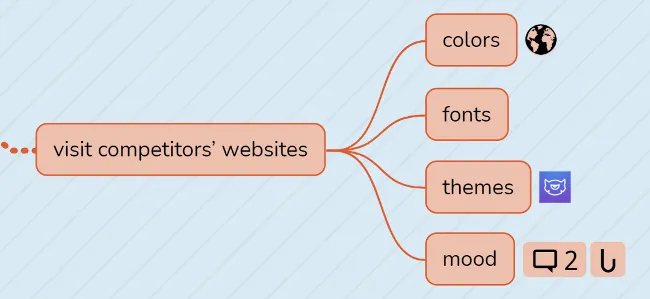
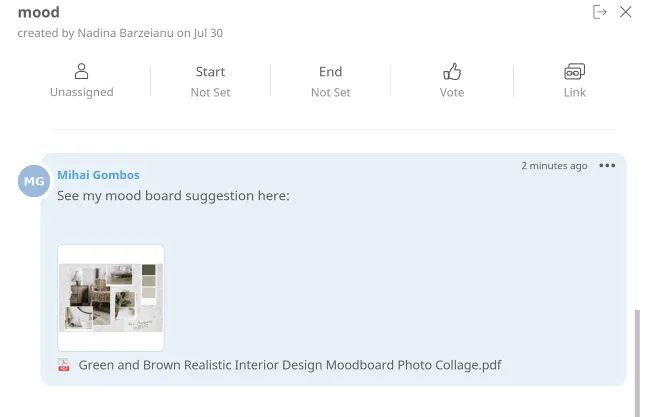
Browse Mindomo’s gallery for inspiration such as these P.L.A.N. website and website planning templates to help you get started.
Business presentations
Section titled “Business presentations”
Business presentations inform, educate, motivate, and persuade internal and external audiences. Either you present company results or pitch a new product, introduce sales, training, and internal communication programs, a well-structured presentation demonstrates professionalism and reinforces an organization’s corporate image.
Create relevant presentations straight from your Mindomo diagrams. Use the power of words and images to communicate your vision and engage your audience.
💡 Tips and Tricks
Easy-to-follow structure (introduction, body, and conclusion) by using either a mind map or a concept map layout.
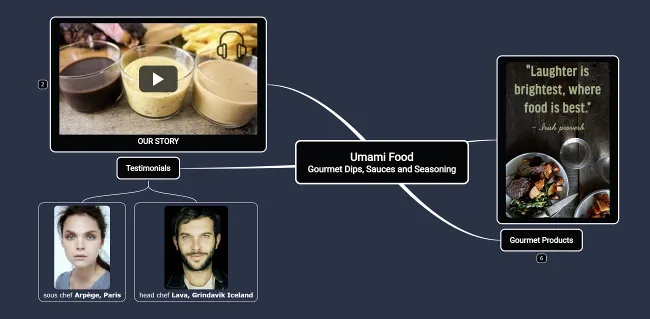
Keep your slide deck to 10 slides in total and ideally six words per slide. This will give the audience a chance to digest the on-screen messages in line with your presentation.
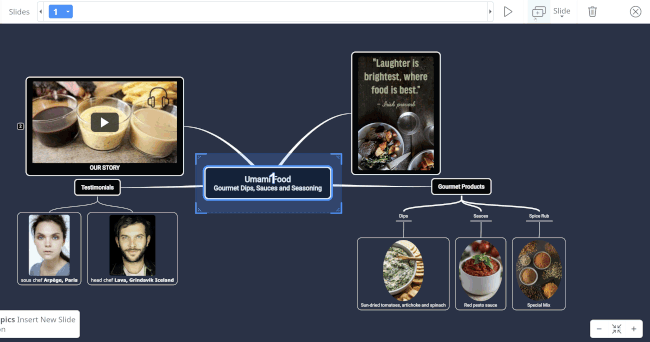
Compelling images and videos will efficiently communicate your ideas and make information easier to remember.

To create a consistent look and feel - use 2 or 3 colors only, same font type, size, color, and formatting in all topics. Format for perfection. You can do this with one topic, then use the copy style option to apply the style to the rest of the content.
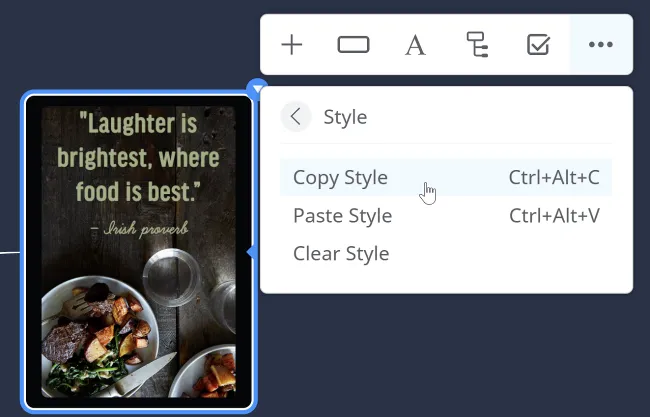
For a smooth delivery, keep in mind that Mindomo enables the use of a clicker or remote to help you face the audience and not have to keep turning back to your laptop to change slides.
Build your presentation on a brand new framework or by using Mindomo’s templates such as the company presentation template or the business proposal template.
Risk management
Section titled “Risk management”
Understanding a company’s exposure and practicing risk management are the first steps toward a healthier business. Knowing the risks you are facing opens the door for efficient problem-solving. In turn, the ability to manage risks helps companies act more confidently on future business decisions. There are various types of risks a company might face, and Mindomo is a reliable tool to map out risk-management plans for:
-
Business Risk
-
Operational Risk
-
Financial Risk
💡 Tips and Tricks
Create a framework for the actions you need to take. Take into account risk management’s five basic steps before creating your diagrams, or use our risk management template:
- Identify the risk
- Analyze the risk
- Rank and Prioritize the risk
- Treat the risk
- Monitor and Review the risk

For step number 4, Treating the risk, you can create a standalone diagram and share it with the experts in the field to which the risk belongs. Keeping everyone focused on the same page will prevent discussions from being broken into different email threads, across documents, spreadsheets, and phone calls. Sharing diagrams and inviting people to edit them is the easiest with the guest editing functionality.
Each collaborator can come with input by editing the diagram and adding personal documents.


Discussions are encouraged in the Comments section where collaborators can discuss the issue, provide solutions, vote to validate inputs, etc.
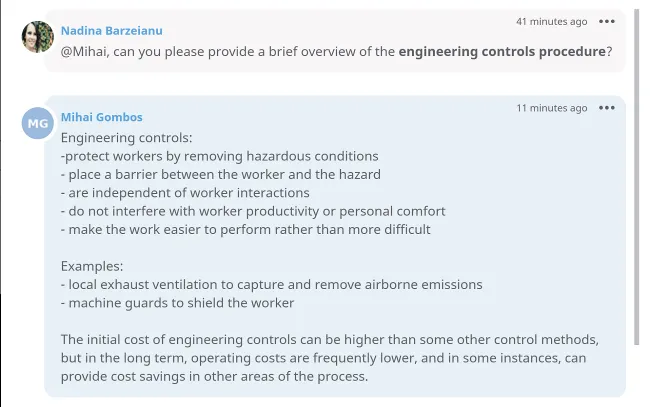
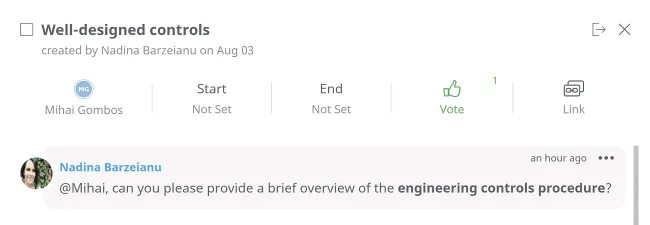
If users are working at the same time on the same diagram, they will be highlighted in different colors.

Keep track of all the changes on your diagram and get a clear overview of the work process with the Playback map history and Changes options.
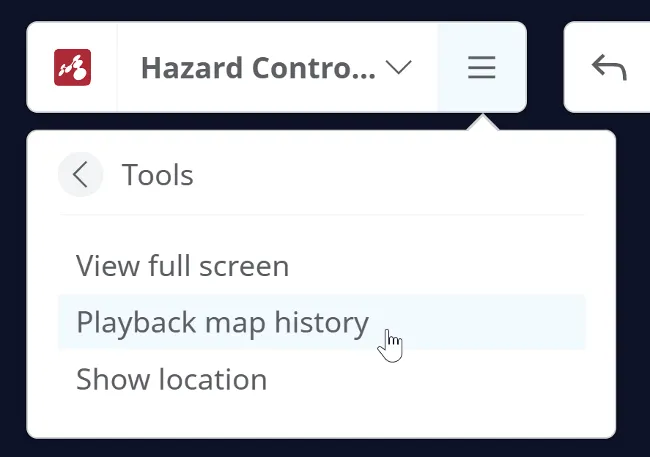

Browse Mindomo’s gallery for predefined templates like these generic risk management and emergency situations planning templates.
Organize your Life Creatively
Section titled “Organize your Life Creatively”Daily Routine
Section titled “Daily Routine”
The professional context might be very different from one person to another, but there are challenges that almost everyone can relate to:
- how to maximize morning time before work starts
- how to get things done during planning time with only 20 minutes available
- how to wrap up the day when there are 30 things to be done and exhaustion kicks in
Diagrams can be used as springboards to figure out how to streamline, simplify, and maximize your time.
💡 Tips and Tricks
Create a vivid work framework having in mind all your to-dos and the best way to prioritize them:
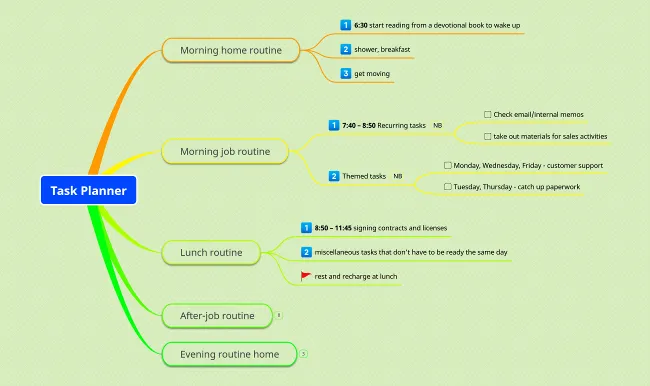
Get started with this task planner template.
Focus on what needs to be done to achieve more in less time. Self-assign tasks that you can later check off to visualize your progress.

Use emojis to highlight priorities:

A weekly planner template can help you plan tasks for the week ahead.
Thinking outside the box
Section titled “Thinking outside the box”
It is more than a cliché that involves thinking of clichéd situations in ways that aren’t clichéd. Conceptualizing problems differently, approaching them in new, innovative ways; and understanding your position about any particular situation in a way you’d never thought of before. Diagramming in Mindomo will help you cultivate the ability to look at things differently from your usual perspective.
💡 Tips and Tricks
Try to look at any problem from different perspectives by combining the highly visual power of mind maps and concept maps with the Six Thinking Hats model:

To avoid fixing problems over and over again, always look for the root of the problem, not just its effects. Mindomo’s fishbone diagram is a visual way to look deep within WHAT and WHY the problem happened.

Become an achiever
Section titled “Become an achiever”
Napoleon Hill’s quote “whatever your mind can conceive and believe, it can achieve” pinpoints the power of living a purposeful life. Having a purpose gives a different meaning to ticking off your boxes of achievements while climbing the personal and professional ladders. Mindomo is your planning and scheduling tool to keep you on track with your goals, tasks, milestones, resources, etc.
💡 Tips and Tricks
Diagrams to help you persevere with your goals and tasks:
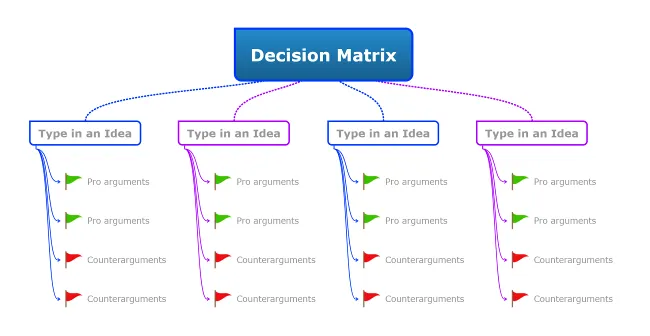
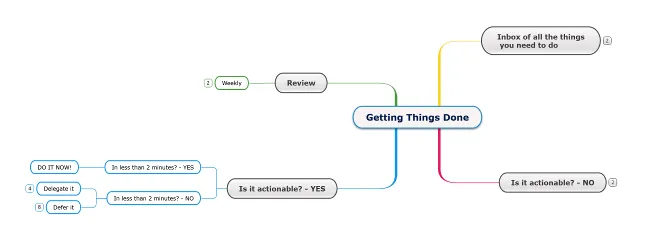
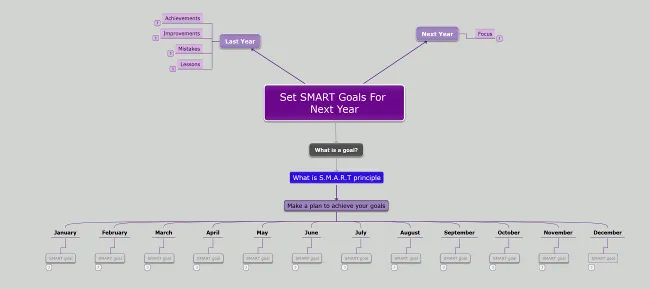
Diagrams to help you prepare for a new job:
Preparing for an interview template
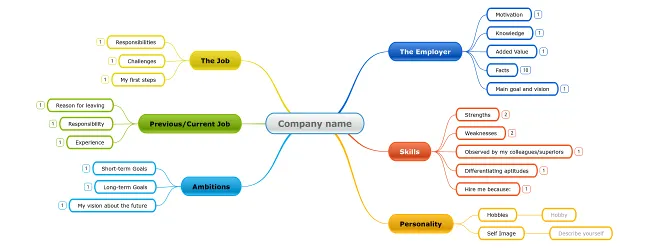

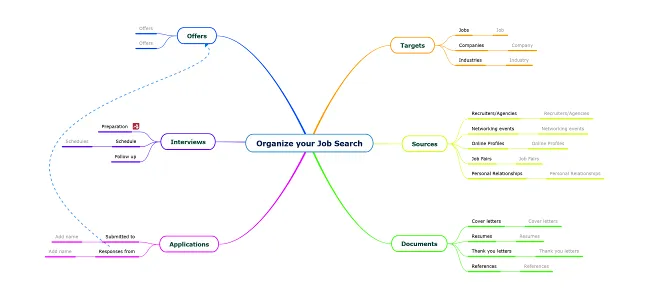
Make sure you set SMART goals:
-
Specific - goals must be clear and well defined so use keywords and /or short phrases.
-
Measurable - assign tasks with precise due dates to measure your degree of success.
-
Attainable - visualize your workflow with the Gantt functionality to coordinate and track specific tasks.
-
Relevant
-
Time-Bound - setting deadlines will favor the achievement.
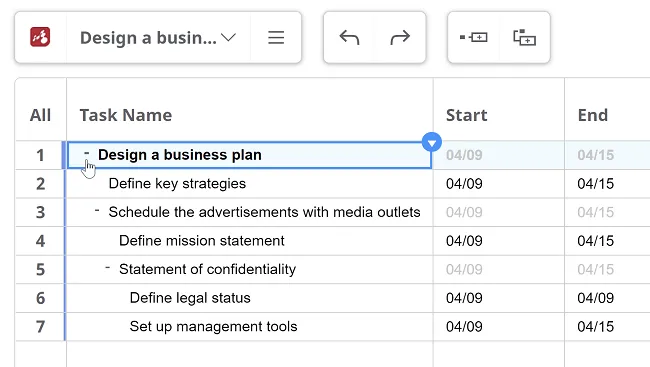
Keep plans simple
Section titled “Keep plans simple”
Mindful planning is vital for all life aspects - setting priorities, working efficiently, building a growth mindset, and having a sense of control over things. Diagramming in Mindomo will help you focus on a combination of planned actions carefully taken one step at a time.
💡 Tips and Tricks
Put plans in motion with inspiring, color-coordinated planners:
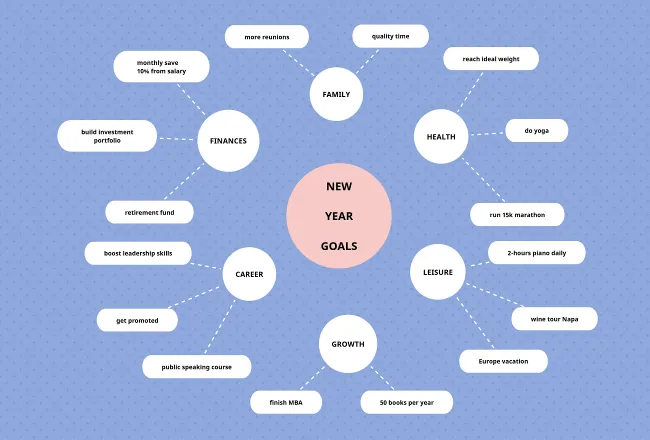

Add emojis for accomplished milestones and delays to keep yourself motivated.
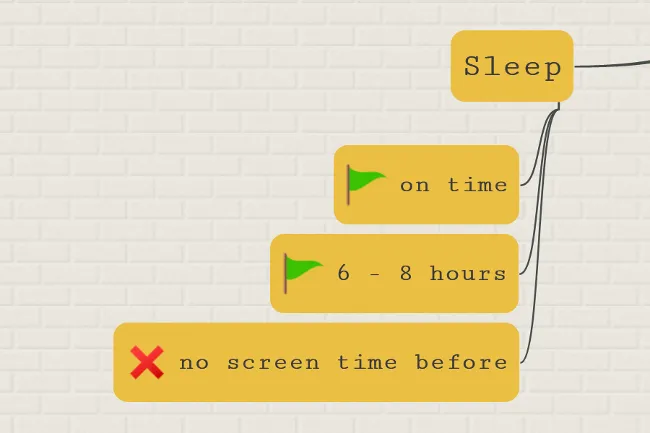
Self-assign tasks that you can later check off to visualize your progress.

